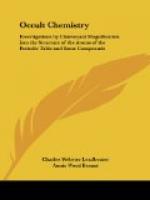GALLIUM (Plate XIII, 2).
In gallium the funnel disappears on the proto level, setting free its two contained segments, each of which forms a cylinder, thus yielding twelve bodies on the proto level. On the meta, the three upper globes in each left-hand segment are set free, and soon vanish, each liberating a cigar and two septets, the quartet and triad uniting. On the hyper the quartet yields two duads but the triangle persists. The second set of bodies divide on the meta level, forming a sextet and a cross with a duad at each arm; these on the hyper level divide into two triangles, four duads and a unit. The seven-atomed cone becomes two triangles united by a single atom, and on the meta level these form a ring round the unit; on the hyper they form three duads and a unit.
In the right-hand segment, the same policy is followed, the four triads becoming two sextets, while the central body adds a third to the number. The second ring has a quartet instead of the sextet, but otherwise breaks up as does that of the left; the quintet at the base follows that of boron.
INDIUM (Plate XIII, 3).
The complication of three segments of different types in each funnel does not affect the process of breaking up, and indium needs little attention. A is exactly the same as the left-hand funnel of gallium, save for the substitution of a globe containing the familiar “cigar” and two square-based pyramids. B is the same as the right-hand funnel of gallium, except that its lowest body consists of two square-based pyramids and a tetrahedron. All these are familiar.
PHOSPHORUS (Plate XIV, 1).
[Illustration]
The atoms in the six similar spheres in the segments of the phosphorus funnel are arranged on the eight angles of a cube, and the central one is attached to all of them. On the meta level five of the nine atoms hold together and place themselves on the angles of a square-based pyramid; the remaining four set themselves on the angle of a tetrahedron. They yield, on the hyper level, two triads, a duad, and a unit. The remaining bodies are simple and familiar.
ARSENIC (Plate XIV, 2).
Arsenic shows the same ovoids and globe as have already been broken up in aluminium (see ante); the remaining sixteen spheres form nine-atomed bodies on the meta level, all similar to those of aluminium, thus yielding twelve positive and twelve negative; the globe also yields a nine-atomed body, twenty-five bodies of nine.
ANTIMONY (Plate XIV, 3).
Antimony follows closely in the track of gallium and indium, the upper ring of spheres being identical. In the second ring, a triplet is substituted for the unit, and this apparently throws the cross out of gear, and we have a new eleven-atomed figure, which breaks up into a triplet and two quartets on the hyper level. The lowest seven-atomed sphere of the three at the base is the same as we met with in copper.




